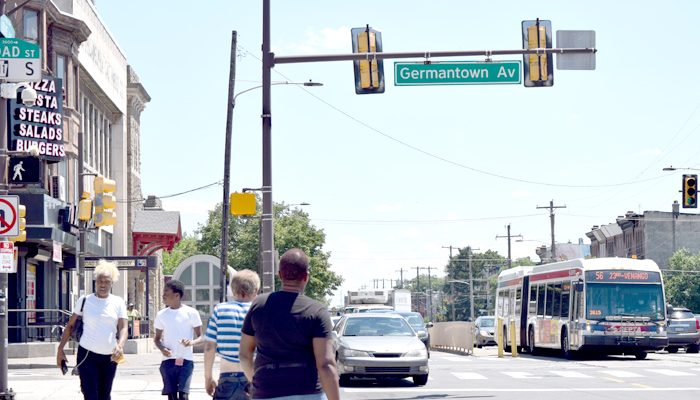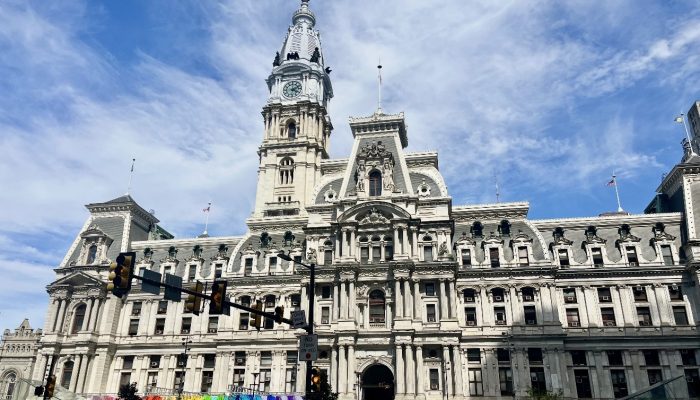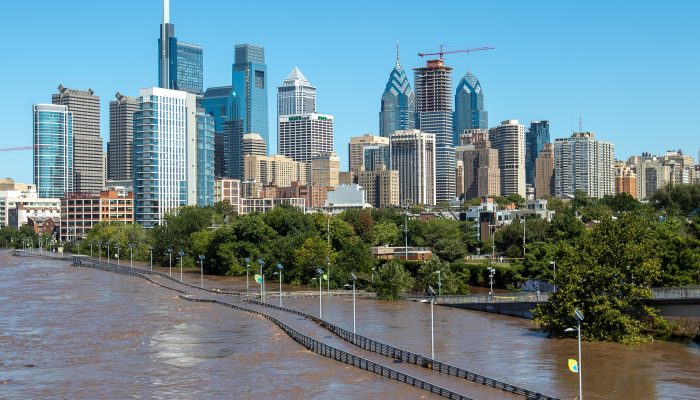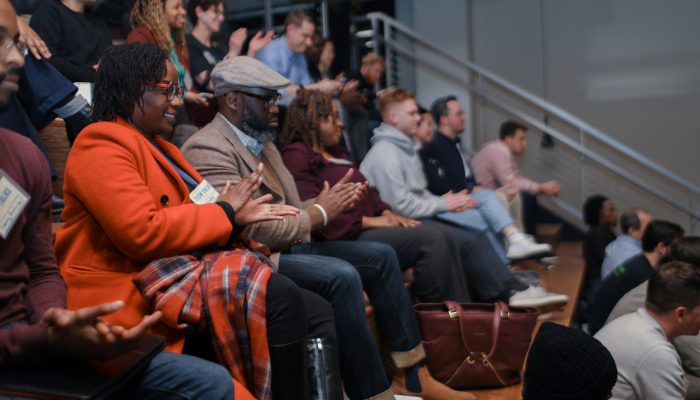Earlier this year the City announced plans for two new public plazas at the intersection of Broad, Germantown, and Erie based on previous phases of community input conducted in 2020. Take a closer look at what the City is also doing to improve traffic safety in this area through major improvements to the roads, sidewalks, crosswalks and bus stops. You can also watch this video explaining these improvements in detail.
Known as ‘the triangles’, these spaces are in the heart of North Philly’s shopping district. Broad and Erie is one of the busiest transit centers in the city. Approximately 20,000 transit riders pass through the intersection each day on SEPTA buses or use the Broad Street Line’s Erie Station. An additional 55,000 more pass through by car each day and 12,000 on foot.
Today, the northern Butler Street triangle, also known as Fish Park, has a fence around it and no seating. The southern Erie Avenue triangle is small and surrounded by stressful traffic. The streets around both triangles form complex intersections. Car crashes that kill or seriously injure someone happen more frequently here than in other areas of the city.
Responding to the North Philly community
In speaking with the community since 2016, the City heard how important it is to improve these triangles and give the neighborhood an improved hub in the commercial area. Throughout these conversations, the City has heard from many residents who recall a time when this area was bustling with shoppers, music, and vibrant storefronts. Honoring this history and building back a welcoming front door for businesses are goals of this project.
To achieve the community’s goals of improved public plazas in the commercial district, the City looked at how to build really nice public spaces. The City found that it was important to:
- make the triangles larger
- make the street safer and reducing dangerous traffic crashes
- add amenities like greenery, shade, lighting and benches.
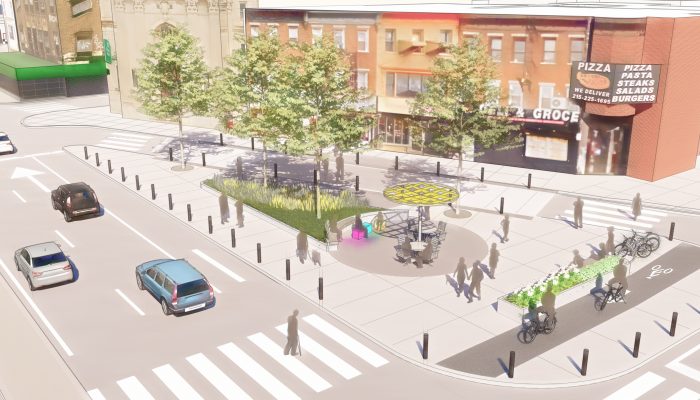
Broad, Germantown, and Erie is dangerous for drivers, walkers, SEPTA riders, and bikers
The most dangerous part of the intersection is Germantown Avenue where it crosses Broad Street. This distance is almost as long as a football field. Car drivers and SEPTA buses have to navigate the unsafe intersection. They often speed on Germantown Avenue to make it to the other side of Broad Street before hitting a yellow or red light. Multiple people have been hit by cars while walking here, including people walking from the corner at the Nicetown-Tioga Library and heading north. This long open intersection is very dangerous.
The City is making the intersection safer
In order to make these streets safer, the City would extend the pedestrian medians in the middle of North Broad. The median would mean that cars and buses can still travel on Broad Street north and south, but if they are travelling on Germantown Avenue they would have to divert a few blocks.
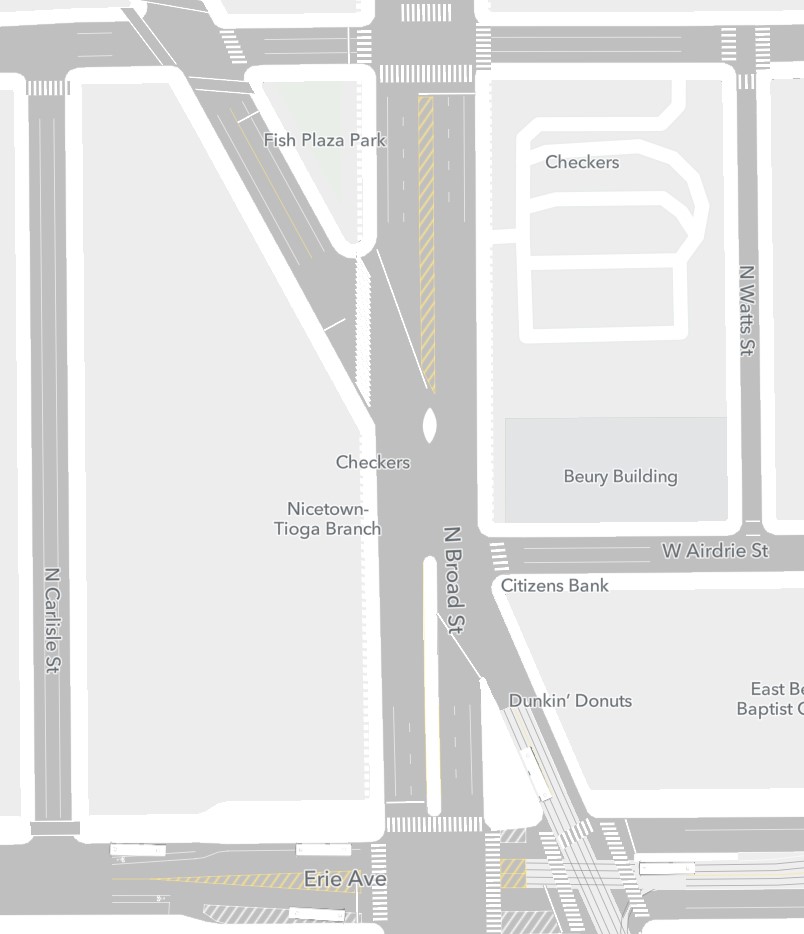
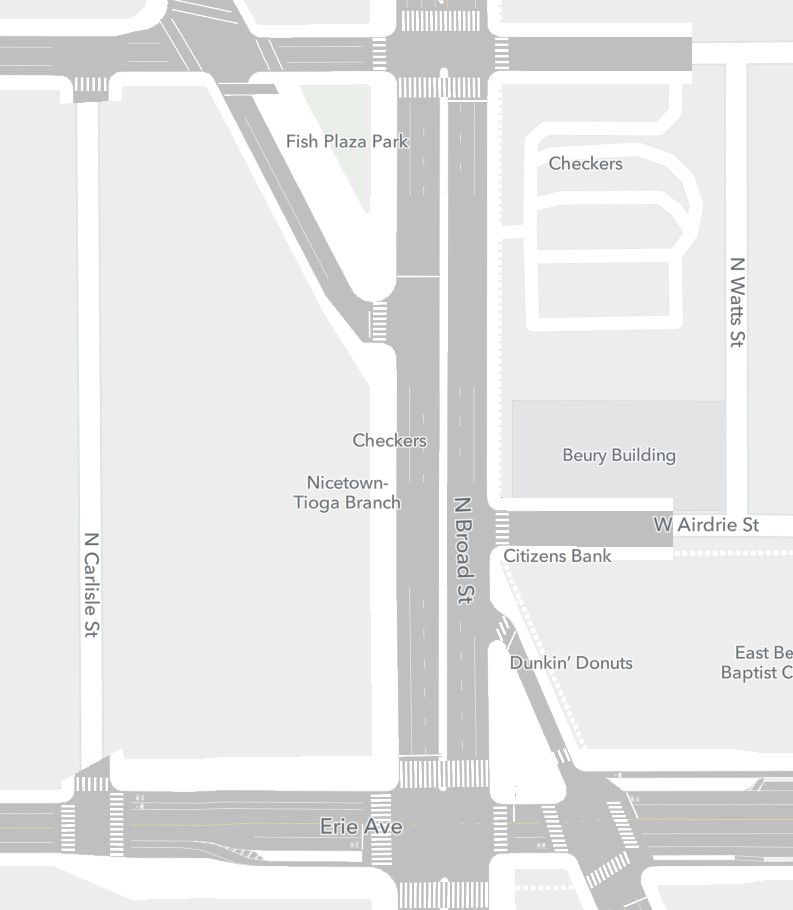
These changes would mean that people driving and riding SEPTA heading north on Germantown Avenue would turn right on North Broad Street instead of traveling through this intersection. If people want to get back on Germantown, they would turn left at Pike Street, just one block north of Butler Street.
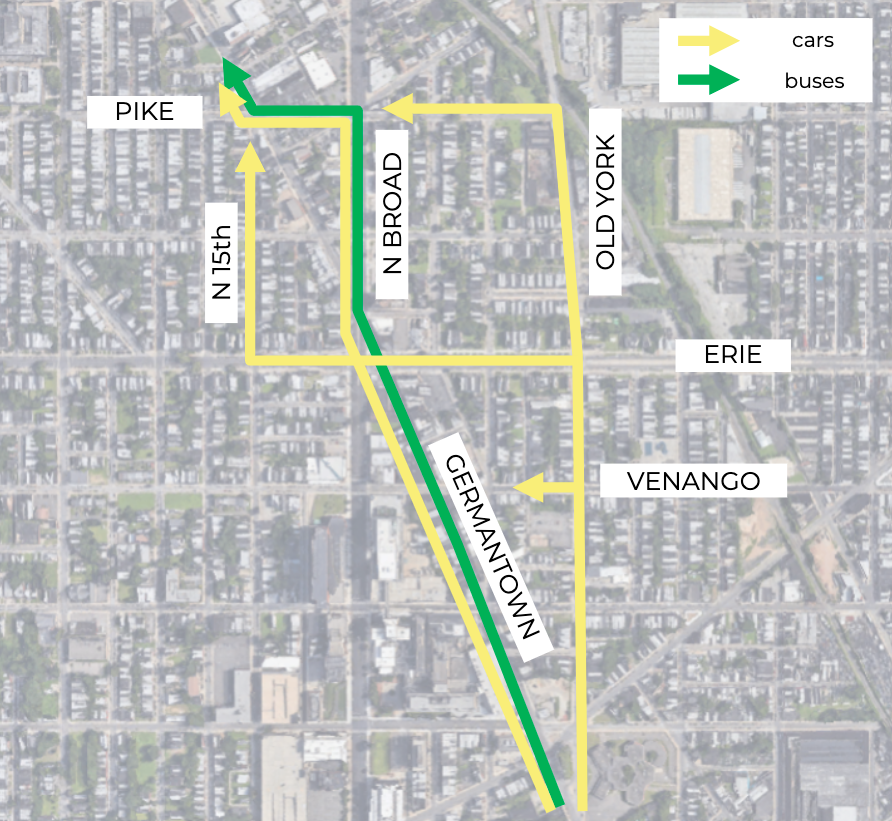
In addition, people driving or riding SEPTA heading south on Germantown would turn right on North Broad instead of traveling through the intersection. If people driving want to get back on Germantown, they would turn left at Tioga Street, or at Ontario Street for SEPTA buses.
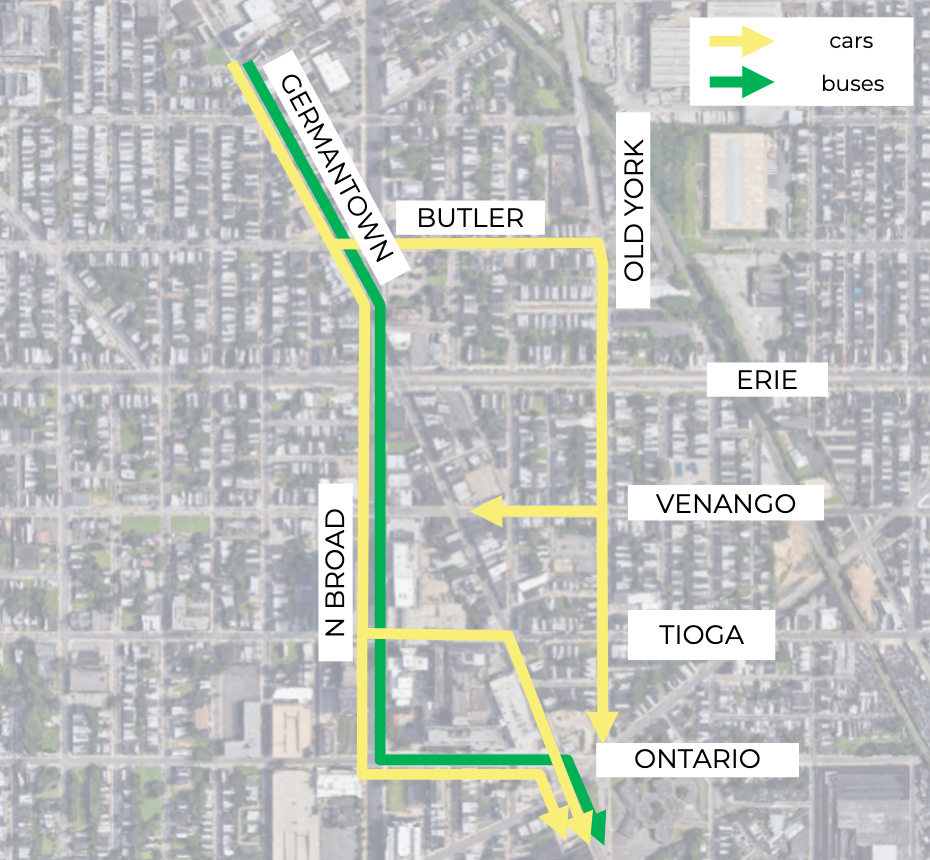
The median would also be a major safety improvement for people walking. Although people should always cross the street at a crosswalk, sometimes people run across Broad Street and get stuck between fast moving cars. Every year someone is hit, seriously injured, or even killed here in this type of crash. With the new medians, a person walking across would be more protected, more visible, and less likely to be hit by a fast car.
The City conducted traffic analysis to determine if these changes would have any negative effects on the roadway network. The study found that today, at the busiest hour of the day – only 153 people per hour are driving north on Germantown Avenue and 140 are driving south. Compared to Broad Street where 1,454 people drive north per hour and 989 people drive south, this is a small amount.
These changes would not cause major congestion or backups. Traffic would flow more smoothly because the traffic signals would better handle the number of cars in each green light phase. Also, there would be reduced conflicts between people driving and people walking, making it safer for people to access stores and the new public spaces. This is because cars would be less likely to block the crosswalks.
What about Erie Avenue?
In addition, the City would rebuild Erie Avenue to improve safety and traffic flow. Erie Avenue at Broad Street would have wider sidewalks with new ADA ramps and shorter crosswalks. Erie Avenue would be repaved from Broad Street to Old York Road, and the old trolley tracks would be removed. With the trolley tracks removed, we could make Erie Avenue safer and easier to use. There would be a sidewalk-height bicycle lane to separate people biking from people walking and driving. This would allow people of all ages to safely bike to the intersection, where they could connect to the subway or a bus.
The SEPTA Route 56 and 53 buses would board at the larger sidewalk, instead of in the middle of the street. There would be a new bus lane on Erie Avenue for the SEPTA Route 56 and 53, making the bus run faster and more efficiently. We would also align the lanes with Erie Avenue west of Broad Street, so people driving don’t experience a lane shift in the middle of the intersection. New bus platforms would make it easier for people getting on and off the bus as they would be adjacent to the sidewalk, rather than in the middle of the street as they are today.


Changing the traffic pattern means bigger, better public spaces
These traffic changes and the median would mean the existing triangles can become much larger public plazas. The southern Erie triangle would increase in size by 60% and the northern Butler triangle would increase by 40%.
The triangles would be rebuilt with upgrades like new trees, grass, pavement, shade structures, benches, tables, chairs and lighting. These elements were selected by the community in a public process in 2020 with almost 800 people giving input. The new triangles would mean the area is cooler during the summer, and more pleasant, beautiful, and relaxing year-round. The City is including elements of literature, which is the theme selected by the community, using a book kiosk, public art, and programming with the Nicetown-Tioga Library.
These new spaces would allow more people to enjoy the shopping district. The goal is to create safer outdoor spaces and draw more customers for local businesses.
In addition to traffic safety, the City is working with the community to improve public safety and respond to gun violence in the area. We’re also committed to a long-term maintenance plan so that these improvements look good for years to come, not just on day one.
What is next?
The City heard new requests this year for additional ways to achieve safety and traffic flow. We are currently exploring these ideas with our traffic engineer. Later this spring, we’ll report back on the results.
Shopping District
- Shopping district assistance is ongoing as the City builds back from COVID-19.
- The City is funding another year of corridor cleaning by working with local partners at Called to Serve and North Broad Renaissance.
Temporary Upgrades this Summer
- The City will be making some short-term improvements to Fish Park, also known as Butler Triangle. More information coming soon.
Construction
- The City is continuing to work in partnership with stakeholders to develop the final plans and get ready for construction in 2022.
- The project is scheduled to be bid at the end of 2021. At that time, local contractors will have an opportunity to submit for the work and the City will follow procurement processes, and is exploring ways to provide opportunities for local contractors.
- We heard loud and clear that local hiring is a priority and are researching ways that are possible to do so.
- The City will coordinate construction with SEPTA’s installation of elevators at Erie Station
Engagement
- There will be a public engagement process for public art at the intersection.
- We will continue to work with stakeholders and the Task Force to get the word out
- Our goal is that no one is surprised when construction starts.
Honoring Local History & Culture
- The project will have a literature theme & public art about neighborhood history and culture
- Historic photos will be part of the short-term improvements this summer
- A committee of neighborhood history enthusiasts is leading a neighborhood history collection and photo essay project. The City submitted a grant application to fulfill their plan to hire local residents to help. Please contact us if you’re a nearby resident who would like to join!
Stay in touch and up to date on the project at phila.gov/bge.
If you’d like a City staff person to come and speak to your group about this project and hear your input, please get in touch at bge@phila.gov or call (215) 436-9886.

